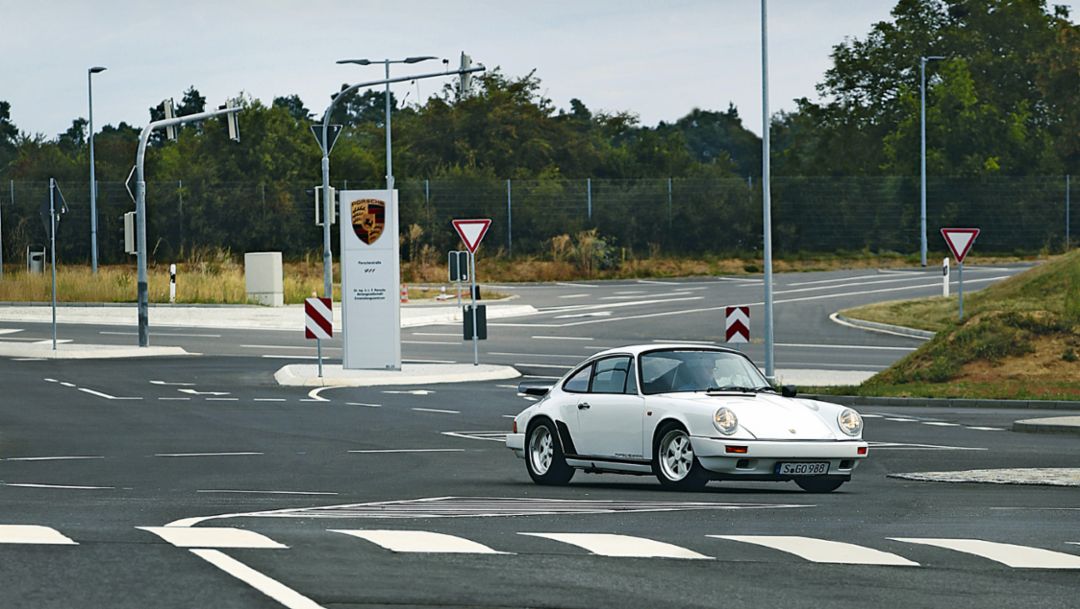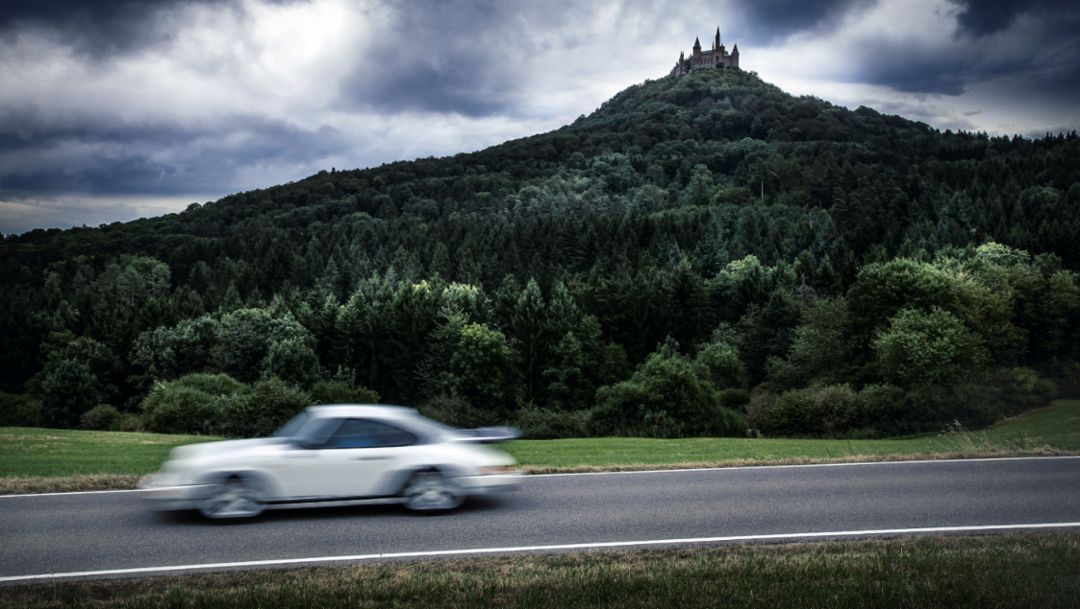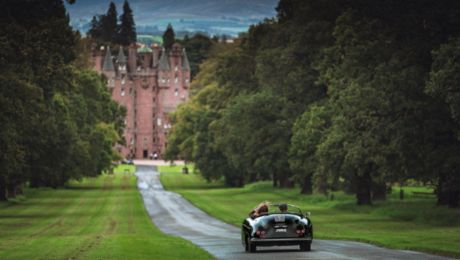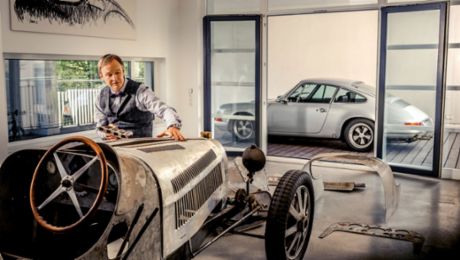Noises everywhere. From the engine, the transmission, the whole drive. A familiar soundscape; and yet louder and closer than what we are used to. It is the acoustics of a prototype. Porsche constructed it to refine the teachings of the pure sportscar. With a 911 Carrera whose aesthetic concept sought a closeness to motorsport. They later called it Club Sport. A coupé which, according to the specifications, was supposed to be 100 kilograms lighter than the Porsche 911 Carrera 3.2 of the time with its 231 hp. And thus a Porsche emerged that, with its scaled-back purity, turned the fascination of the 911 into an unforgettably authentic sportscar experience. The basis for the prototype was provided by a vehicle with the identification number WP0ZZZ91ZF100848. The “F” stands for the year 1985, while “848” is the serial production number. It is one of the sportscar manufacturer’s great treasures. A unique specimen, which helped Porsche become skilled in the art of renouncement.
Three decades after the vehicle was built, we have taken it back to where the story began: in Werk 1, the first Porsche plant, in Stuttgart-Zuffenhausen. Sitting inside the first 911 Carrera Club Sport we follow in the tracks of its history, driving past the Porsche Museum to the right of the roundabout at Porscheplatz and turning off in the direction of Weissach. This stretch of road has served as an automotive lifeline connecting Porsche Werk 1 and the Porsche Development Centre since the summer of 1971. People like Ferry and F. A. Porsche drove this route, and with them generations of engineers and designers. Anyone who owns a Porsche, be it a new vehicle or a classic, should make a pilgrimage to these streets once in their lives – either before or after the local rush hour. It is a short journey through the geographical centre of the world of Porsche.
Built only 99 times: the Porsche 911 Carrera Club Sport of the G-series
Just as in 1985, when that year’s “serial number” 848 took this route for the first time, late in the summer of 2016 we drive the 911 towards Weissach once more, round behind the small town of Schweiberdingen in the direction of Hemmingen, and later turning left to continue towards Weissach. These are small country roads, on which great cars were fine-tuned. Cars such as the G-series Porsche 911 Carrera Club Sport, introduced in 1987 and built only 99 times. In the original model for this series, we reach Weissach. This is where it was constructed; from here it set off into the Swabian Alps, transforming an idea into a fascinating driving machine which would go on to excite and inspire people in motoring hotspots all over the world.
The 3125 cm³ engine (according to the registration document) of the first Club Sport ever crackles on the car park in front of the gate to the Porsche Development Centre. Slowly we get to know it better, this priceless gem. On the outside, it looks completely different from the later Club Sport standard models. Visually it recalls much more strongly the Porsche 911 SC RS produced two years previously in a limited run of just 20 vehicles; the series was made for the purposes of homologation for Group B in rally sport. Instead of the typical G-model bumper, the prototype in fact has its counterpart from the 911 SC RS painted entirely in the vehicle colour; however, at the rear the body of the Club Sport is narrow and not turbo-wide. Like the “SC RS”, the paint of the Club Sport is White; even the Fuchs wheels with their centres painted in White appear to have been taken directly from the special series. It is hard to get rid of the impression that many parts of the 911 SC RS have simply been used for the prototype. Even in the interior there are parallels. For example, as in the SC RS, the prototype is missing the centre console (including hazard warning light switch and button for the heatable rear window).
Nonetheless, the “CS” is not by any means an “SC RS”. And yet, we have to consider the homologation series if we want to understand the “Club Sport”. Instead of the “new” 3.2-litre engine, the “SC RS” still had the “old” 3.0-litre engine on board, with, however, a motorsport injection system from Kugelfischer and now a power output of 250 instead of 204 hp. The price of the 911 SC RS with its extremely complex design: 188,100 German marks. By way of comparison, a “normal” Carrera 3.0 SC was available at prices starting from 55,650 marks in 1983. The “SC RS” was therefore much too expensive for mass sports. Nor was it destined for a great career in works rally sports, as shortly afterwards the all-wheel drive spelled the end for the rear-wheel drive on fast dirt roads. Porsche met this fact head-on with its all-wheel drive works rally vehicles, which won the Paris–Dakar Rally in 1984 (911 Carrera 4x4) and 1986 (959). The rear-wheel drive 911 SC RS meanwhile remained what it was: a wonderfully light (1057 kg) road sportscar. What was missing from the Porsche repertoire of the day, however, was a more affordable basic model for mass sports. One such as there had been in the legendary 911 Carrera RS 2.7, launched exactly ten years before the 911 SC RS, which had been available in a comfortable touring version and a razor-sharp sports version. It is safe to assume that these two 911s – the 911 Carrera SC RS and the 911 Carrera RS 2.7 – both served as sources of inspiration for the new 911 Carrera Club Sport.
Following the tracks of its history
From Weissach, we take this unique vehicle out into the Swabian Alps. These are routes on which Porsche engineers took cars such as the first 911 Carrera Club Sport to be honed and refined many years ago, and where prototypes are still out and about today. Country roads with plenty of curves, which lead past historic landmarks such as the venerable Hohenzollern Castle – the seat of the House of Hohenzollern – in the small town of Hechingen. Doing 100 km/h on the country road, the 3.2 or, if preferred, 3.1-litre engine does just under 2000 rpm in fourth gear. The tachometer, which goes up to 300 km/h, still has less than 34,000 km on the clock. In previous years, the tachometer’s needle is said to have worked its way up to 260; in view of more than three decades since it was launched we forgo a personal experiment and trust the vehicle papers, which claim 245 km/h as the Vmax. Still, on numerous stretches in the Swabian Alps – for example in the incredible Glastal valley or the Great Lautertal at Hayingen – we bravely shift down the gears to spur on the naturally aspirated engine in the front.
Back then, when there was just one “turbo”, vacuum units such as the 930 of the first Club Sport were still heavily reliant on the engine speed. The old engine responds to the request for power as if it had been produced yesterday. It can be turned up to 6840 rpm; the red range of the tachometer was moved specifically to accommodate this. From a standing start, the six-cylinder would presumably still today catapult the 911 up to 100 km/h in 5.9 seconds. But who does a thing like that, revving an engine such as this up to the rpm limit while stationary, then releasing the clutch pedal and slamming through second gear until the 100 km/h mark is reached? Very few people realise that this figure – a magical value to so many – is derived in such a nonsensical manner. Incidentally, the name given to the Club Sport experimental vehicle internally was the “911 F 22, prototype sports package 2”.
A lovingly designed car that nonetheless missed its aim of being equipped with an “affordable” club sports package. This is because the development team – as you can imagine – took from the 911 SC RS expensive parts like the wing, doors and bonnet top made of aluminium. But the lightweight metal parts would not survive the transition to series production, any more than the experimental vehicle’s instrument panel reduced to three displays. One feature that was, rather unusually, already present on the left wing and the right edge of the roof of the prototype, and remained, was the logo “CS Club Sport”. Otherwise, the people at Porsche also stuck with purest minimalism for the series version with the equipment package “M637” in order to tease out the maximum agility. Underbody protection: gone. Rear seat assembly: gone. Automatic temperature regulation: gone. Passenger sun visor: gone. Sound absorber and insulation (except in the engine compartment and roof lining): gone. Carrera logo on the rear end, clothes hook and lid of the door storage box: gone. The fog lights, engine and luggage compartment lighting and, of course, the power windows were also left in the workshop.
As a driver you are more free
The engine featured new inlet valves and a new control unit (with a higher maximum engine speed), a modified crankcase and other cylinder heads – all fine-tuned on the racing circuit. The vehicle also included a sportier shock absorber and harder engine mounts. Not included: Air-conditioning; comfort, leather or electronic sports seats; rear wiper; alarm system; central locking system; radio; and sliding roof. These absences on board the Porsche 911 Carrera Club Sport a.k.a. “911 F 22, prototype sports package 2” are missed by precisely no one. On the contrary, as a driver you are more free, because you do not constantly have to operate, understand or communicate something. Because all that is left is the 911. A machine that, with every noise coming from its drive and every bit of feedback given by the ESP-free chassis, communicates quite clearly that it is in motion and you should kindly concentrate on that. And only on that. It is a kind of mental training, which sharpens the senses and puts your thoughts in order.
911 Carrera Club Sport
Technical data for the prototype
Engine: Flat engine in the rear
Cylinders: 6
Displacement: 3125 cm3
Max. power: 231 hp/170 kW
Maximum revs: 6840 rpm
Power transmission: Rear-wheel drive
Transmission: Fully synchronised 5-speed transmission
Weight empty: 1160 kg
Front tyres: 195/65 VR 15, rims 7J x 15
Rear tyres: 215/60 VR 15, rims 8J x 15
Vmax: 245 km/h
0–100 km/h: 5.9 seconds
0–1000 m: 25.9 seconds
Info
Text first published in the magazine "Porsche Klassik 10".
Text by Thomas Fuths // Photos by Stephan Lindloff
Copyright: The image and sound published here is copyright by Dr. Ing. h.c. F. Porsche AG, Germany or other individuals. It is not to be reproduced wholly or in part without prior written permission of Dr. Ing. h.c. F. Porsche AG. Please contact newsroom@porsche.com for further information.




-2.jpg/jcr:content/Porsche%20911%20S%202,0%20Targa%20(1967)%202.jpg)
